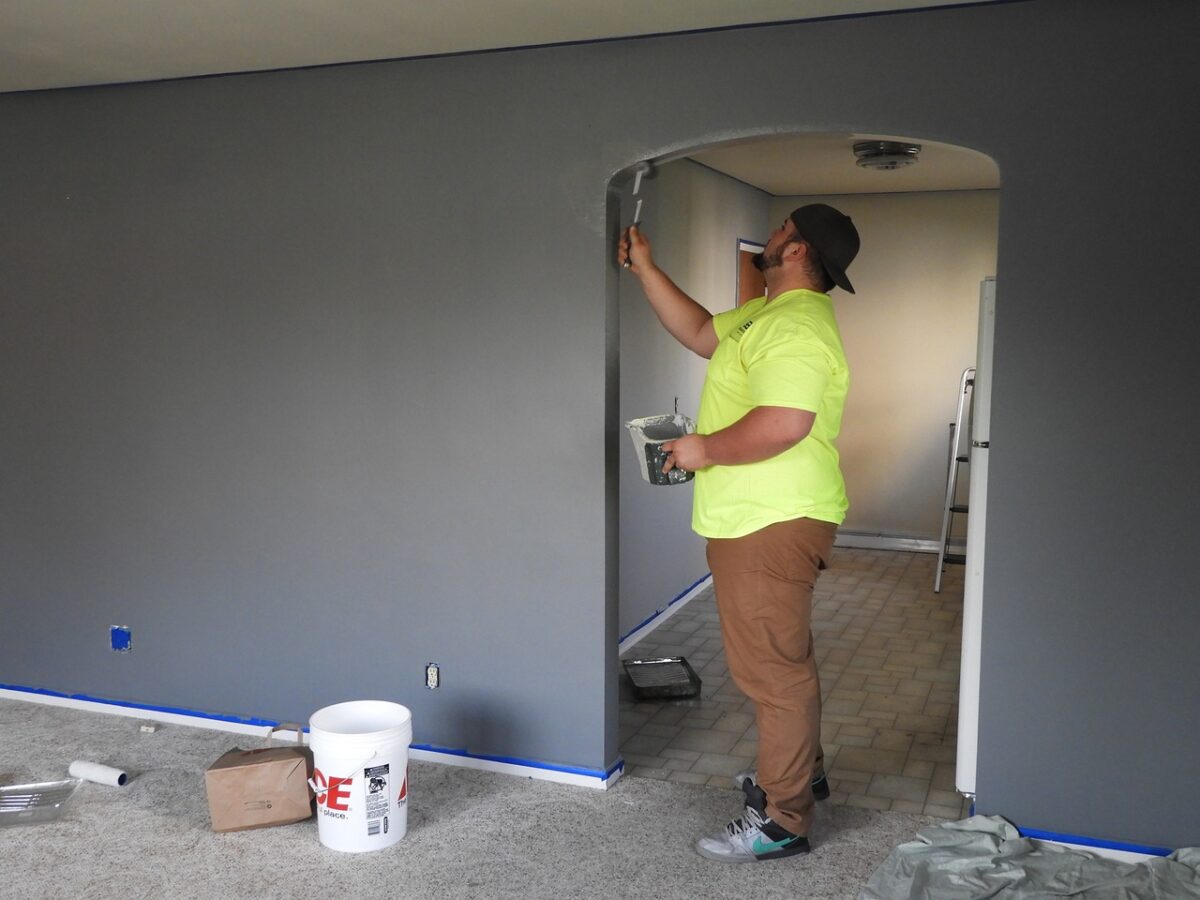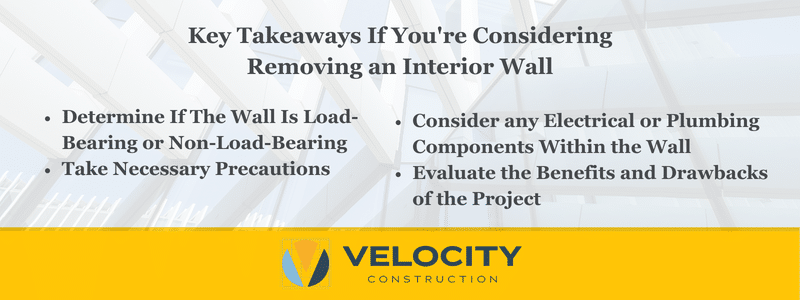How Removing Walls Can Transform Your Home Renovation
In recent years, one trend that has gained significant popularity is removing walls to create open-concept living areas. Removing walls is an effective way that homeowners can transform their homes, from increasing natural light and improving flow to creating expanded space for entertaining and spending time with family.
In this article, we will explore the benefits of wall removal in Nashville, TN, and why it has become a popular choice for homeowners in the area.
Benefits of Removing Walls During Home Renovations
Removing walls during home renovations in Nashville, TN can have numerous benefits for homeowners, whether it’s removing a half wall, tearing out a wall, or replacing walls in a house altogether. One of the main advantages of removing walls is that it can create a more open and spacious feel in a home, especially if the renovation involves opening up the living, dining, or kitchen areas.
By eliminating walls, natural light can flow more freely throughout the space, making it feel brighter and more inviting. Additionally, removing walls can improve the flow and functionality of a home, allowing for easier movement between rooms and more flexible use of the space.
Tearing out walls can also create opportunities to add storage or built-in features, such as shelves or cabinets, that can improve organization and maximize space.
Finally, replacing walls in the house can also be an excellent opportunity to upgrade the home’s insulation, electrical wiring, or plumbing, leading to increased energy efficiency and reduced utility costs over time.
How To Remove Walls Safely Without Damaging Structures
Removing walls during home renovations can be an exciting way to create an open space on the main floor, but it’s essential to take proper precautions to ensure that the structure of your home remains safe and sound.
The first step in safely removing walls is to consult with a structural engineer or a knowledgeable residential contractor who can help you identify which walls can be removed without compromising the integrity of the building. Before beginning the demolition process, it’s important to identify any wall studs, electrical boxes, plumbing pipes, or other features that may need to be relocated to accommodate the new space.
Additionally, if the walls you are removing are exterior walls or load-bearing walls, you will need to install temporary supports to ensure that the weight of the roof and other structures are adequately supported during the demolition. Once you have taken these necessary precautions, you can use a pry bar to carefully remove wall plates and adjacent walls without damaging any electrical wires or other fixtures.
By following these steps, you can safely remove walls and create an open space on the main floor of your home.
Factors To Consider Before Removing a Wall
When considering removing a wall in a home renovation project in Nashville, TN, there are several essential factors that homeowners need to keep in mind.
First and foremost, it’s important to determine if the wall contains any electrical lines, light switches, or outlets. If it does, you should hire a licensed electrician to ensure that any electrical work is properly relocated to comply with building codes. If the wall has water pipes inside of it, you’ll also need to hire a plumber.
Second, it’s essential to know whether the wall is a load-bearing wall or not. Removing a load-bearing wall could cause significant damage to the existing ceiling and other structures of your home, so it’s crucial to get professional advice before beginning any DIY project.
Third, you may need a building permit and electrical permits to remove drywall, wood paneling, or other materials that may be covering heating or cooling ducts, ceiling joists, flooring joists, or other essential structures.
Fourth, homeowners need to be aware of the potential presence of crawl space and cover vents to avoid any damage to the home’s foundation.
By taking all these factors into account, homeowners can make informed decisions about whether to remove a wall and how best to proceed with their home renovation project.
Average Costs of Removing Walls for Open Floor Plan
The cost of removing a wall to create an open floor plan in a home renovation project can vary widely depending on several factors. These factors include the size and location of the wall, whether the wall is load-bearing or not, and the complexity of any electrical or plumbing work that may need to be relocated.
In general, homeowners should expect to spend anywhere from $1200 to $5000 on the project. The national average cost of removing walls is $2500.
If the wall is load-bearing, the cost may be higher due to the need to install additional support beams or columns. Other costs include any necessary flooring or ceiling repairs, moving or adding doors, and installing new lighting fixtures.
While the cost of removing a wall for open floor plans can be a significant investment, it can add value to your home and create a more functional and aesthetically pleasing living space.

Commonly Asked Questions About Removing Interior Walls
Removing interior walls is a popular home renovation project in Nashville, TN that can transform the look and feel of your living space.
However, it can also be a difficult job that requires careful planning and execution. You can find some commonly asked questions about removing interior walls answered below.
How do you tell if you can remove an interior wall?
Before beginning any interior wall removal project, it’s important to determine if the wall is load-bearing or not. Load-bearing walls are essential to the structure of the home and removing them without proper support can cause serious damage.
Additionally, homeowners should consider the electrical, plumbing, and HVAC that may be running through the wall.
It’s also important to consider the purpose of the wall. Some interior walls may be necessary for privacy, noise reduction, or to separate spaces.
What is a load-bearing wall?
A load-bearing wall is a structural component of a building that supports the weight of the structure above it. This can include the weight of the roof, upper floors, and any other structural elements.
Load-bearing walls are typically thicker and stronger than non-load-bearing walls and are often perpendicular to the joists or beams of the building’s frame. Removing a load-bearing wall can have severe consequences, such as compromising the structural integrity of the building.
Therefore, if you are considering removing part of the load-bearing wall, it’s crucial to seek the guidance of a structural engineer or experienced contractor.
Do I need permission when tearing down a wall in my house?
In many cases, tearing down a wall in your house will require some form of permission or permit. This can vary depending on the location of the home, the type of wall being removed, and the scope of the project.
In general, if the wall is load-bearing or if electrical or plumbing work will be affected, a permit will likely be necessary. Additionally, it’s important to work with a licensed and insured residential contractor who can ensure that the project is completed safely and up to code.
What is a half-wall?
A half-wall, also known as a knee wall or pony wall, is a type of wall that is shorter in height than a standard wall and is typically used to partially divide a room or to support a countertop or railing. Half-wall structures are often used in open-concept living spaces to define separate areas while maintaining an open feel.
When removing a half-wall structure, it’s important to evaluate whether it is providing any necessary support (these are typically not load-bearing walls) and to take proper measures to reinforce the structure if needed.
As with other walls, there might be electrical lines, plumbing pipes, or HVAC within the wall, so it’s best to check before tearing it down.
How do you remove a wall to the outside?
Removing a wall to the outside of a building can provide increased natural light and improved access to outdoor spaces. Exterior walls are typically load-bearing walls, so you’ll want to know what you’re dealing with before removal, or risk compromising the structural integrity of your home.
To remove the wall, the drywall or plaster will need to be carefully removed, and any nails or screws holding the wall in place will need to be removed.
Depending on the type of wall and the construction of the building, additional steps may be necessary, such as installing a header or additional framing. It’s important to take proper precautions, such as wearing eye protection to avoid injury and using the correct tools to prevent damage to the structure.
Can I remove an internal wall myself?
Whether or not you can remove an internal wall yourself depends on several factors, including the type of wall, the construction of the building, and your own experience and skill level.
In general, a non-load-bearing wall and walls that do not contain electrical or plumbing components can be safely removed by a skilled DIYer, provided that proper precautions are taken and all necessary permits and approvals are obtained.
However, removing a load-bearing wall or a wall that contains electrical or plumbing components requires a more advanced level of knowledge and skill, and it is recommended that you consult with a structural engineer or licensed contractor before attempting the project yourself.
Key Takeaways If You’re Considering Removing an Interior Wall
Removing an interior wall can be a complex and challenging project, but it can also transform the look and feel of your home. If you’re considering removing an interior wall, there are several key takeaways to keep in mind.

Determine If The Wall Is Load-Bearing or Non-Load-Bearing
Here’s how you can identify a load-bearing wall. Load-bearing walls are usually thicker and responsible for supporting the weight of the building and are typically located perpendicular or parallel to the roof or floor joists.
Load-bearing walls often have beams or columns that transfer the weight to the foundation or other load-bearing structures.
Removing a load-bearing wall can have structural implications, so consult a professional to ensure the proper support is in place.
Consider any Electrical or Plumbing Components Within the Wall
Safely reroute or relocate these elements to maintain functionality. Prepare the new area by spreading drywall mud and using drywall screws to create a smooth surface.
Take Necessary Precautions
Protect other rooms and components during the demolition process. If you’re uncertain about the project’s complexity, seek professional help to ensure safety and compliance with building codes.
Evaluate the Benefits and Drawbacks of the Project
Weigh the removal of load-bearing wall pros and cons before undertaking the project, including the impact on space, lighting, and overall aesthetics. With proper planning and guidance, removing an interior wall can transform your living space, but it’s crucial to approach the project thoughtfully and responsibly.
Tips for Incorporating Open Spaces Into Your Design Plans
Open layouts create a sense of spaciousness, promote better flow and communication, and allow for more natural light. Here is a list of tips, to help you navigate the process of incorporating open spaces into your design plans.
Determine the Purpose of the Space
Before removing any walls, consider the intended use of the space. This will help you decide which walls to remove and what type of open space you want to create.
Consider the Structural Implications
If you’re removing walls, it’s important to determine if they are load-bearing or not. You’ll need to work with a professional to ensure the structural integrity of your home isn’t compromised.
Optimize Lighting
Open spaces can often result in darker corners and less natural light in the center, away from windows. Consider incorporating skylights, larger windows, or adding lighting fixtures to enhance the brightness of the space.
Create a Cohesive Design
When designing an open space, ensure that it flows seamlessly with the rest of the room. Use similar colors, materials, and textures to create a cohesive look throughout.
Removing a Half-Wall
Removing half-walls can be an easy and effective way to create a more open space while still maintaining some level of separation.
Add an Island or Peninsula
Incorporating an island or peninsula in your kitchen, where a wall has been removed, can create an open floor plan while maintaining a distinct cooking and dining space.
Don’t Forget About storage
Open spaces can often result in less storage. Consider incorporating built-in shelving or cabinets to ensure you have enough storage for your belongings.
Keep it Balanced
When creating an open space, ensure that it’s balanced and not too cluttered. Don’t be afraid to experiment with different layouts and furniture arrangements until you find the perfect balance.
Should I Hire Professionals for Removing a Wall in a House?
If you’re looking to remove walls in your home to create open spaces and enjoy the fun part of home renovation, consider hiring a professional construction company like Velocity Construction in Nashville, TN. While DIY may seem tempting, removing walls is a complex and potentially dangerous process that requires expert knowledge and equipment.
Contact us today to get started on your wall removal project and turn your home into a more spacious and functional living space.

